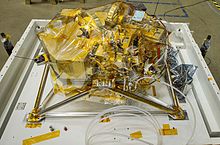

NIRCam (Near-InfraRed Camera) is an instrument aboard the James Webb Space Telescope. It has two major tasks, as an imager from 0.6 to 5 μm wavelength, and as a wavefront sensor to keep the 18-section mirrors functioning as one.[1][2] In other words, it is a camera and is also used to provide information to align the 18 segments of the primary mirror.[3] It is an infrared camera with ten mercury-cadmium-telluride (HgCdTe) detector arrays, and each array has an array of 2048×2048 pixels.[1][2] The camera has a field of view of 2.2×2.2 arcminutes with an angular resolution of 0.07 arcseconds at 2 μm.[1] NIRCam is also equipped with coronagraphs, which helps to collect data on exoplanets near stars. It helps with imaging anything next to a much brighter object, because the coronagraph blocks that light.[2]
NIRCam is housed in the Integrated Science Instrument Module (ISIM), to which it is attached by struts.[3][4][5][6] It is designed to operate at 37 K (−236.2 °C; −393.1 °F), so it can detect infrared radiation at this wavelength.[3][7] It is connected to the ISIM by struts and thermal straps connect to heat radiators, which helps maintain its temperature.[3] The Focal Plane Electronics operated at 290 K.[3]
NIRCam should be able to observe objects as faint as magnitude +29 with a 10,000-second exposure (about 2.8 hours).[8] It makes these observations in light from 0.6 to 5 μm (600 to 5000 nm) wavelength.[4] It can observe in two fields of view, and either side can do imaging, or from the capabilities of the wave-front sensing equipment, spectroscopy.[9] The wavefront sensing is much finer than the thickness of an average human hair.[10] It must perform at an accuracy of at least 93 nanometers and in testing it has even achieved between 32 and 52 nm.[10] A human hair is thousands of nanometers across.[10]
- ^ a b c "NIRCAM". Retrieved 5 December 2016.
- ^ a b c "The James Webb Space Telescope". Retrieved 5 December 2016.
- ^ a b c d e "NIRCam Instrument Overview". NASA. Retrieved March 9, 2023.
- ^ a b "NIRCAM". Retrieved 6 December 2016.
- ^ "The James Webb Space Telescope". Retrieved 6 December 2016.
- ^ "Instruments and ISIM (Integrated Science Instrument Module) Webb/NASA". Archived from the original on 2016-12-03. Retrieved 2016-12-06.
- ^ "NirCam". www.lockheedmartin.com. Retrieved 2017-01-21.
- ^ "Detecting the Most Distant Supernova in the Universe" (PDF). Retrieved November 12, 2022.
- ^ Greene, Thomas P.; Chu, Laurie; Egami, Eiichi; Hodapp, Klaus W.; Kelly, Douglas M.; Leisenring, Jarron; Rieke, Marcia; Robberto, Massimo; Schlawin, Everett; Stansberry, John (2016). "Slitless spectroscopy with the James Webb Space Telescope Near-Infrared Camera (JWST NIRCam)". In MacEwen, Howard A; Fazio, Giovanni G; Lystrup, Makenzie; Batalha, Natalie; Siegler, Nicholas; Tong, Edward C (eds.). Space Telescopes and Instrumentation 2016: Optical, Infrared, and Millimeter Wave. Vol. 9904. pp. 99040E. arXiv:1606.04161. doi:10.1117/12.2231347. S2CID 119271990.
- ^ a b c "Lockheed Martin Readies One of the Most Sensitive IR Instruments Ever Made for NASA Telescope". www.lockheedmartin.com. Retrieved 2017-01-21.